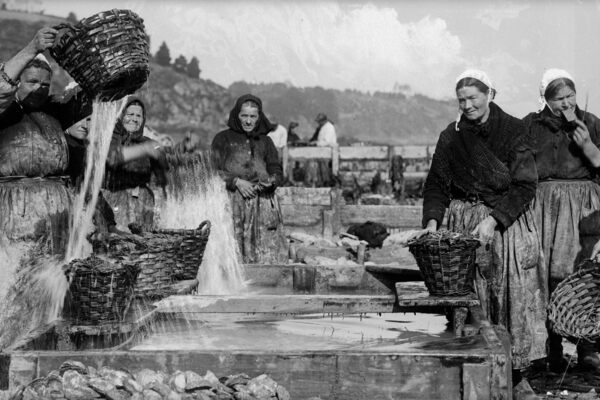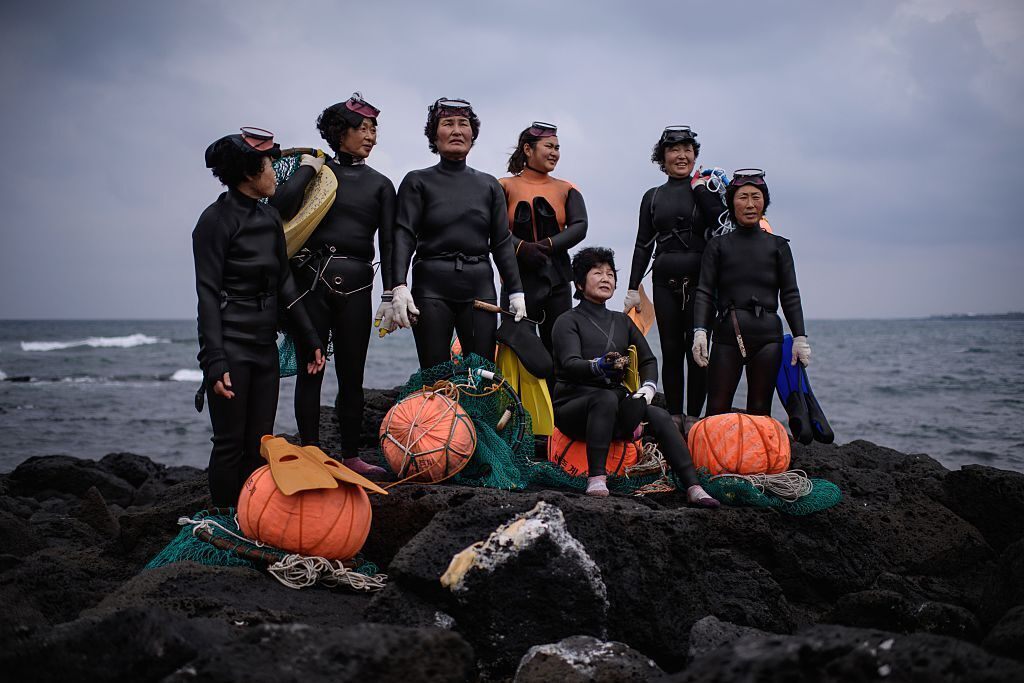Three elderly women are teaching the music of these famed fisherwomen.
Kang Kyung-ja opens the door of her home on the island province of Jeju, South Korea, with a smile on her face. After offering me a cup of barley tea, she unfolds a piece of paper to sing me a song she’s written.
Ieodo sana, ieodo sana, ieodo sana
Where to go, where to row
All aboard to the depths of the sea
Where my mother gave birth to me
Did she know to dive would be my destiny?
Her husband, in the next room practicing calligraphy, joins along for the parts she cannot sing on her own. Let’s buy a house with a field, baked in the sun. Let’s enjoy life and have some fun, he sings.
They
laugh, show me family photos, and bring out plates of watermelon and
tomatoes they’ve grown in their garden. Kang, a 73-year-old former haenyeo, admits straightaway she has not lived the typical haenyeo life. “I’m not like other haenyeo. I’m very happy,” she says.
Nonetheless,
for several years she has been training to preserve haenyeo songs.
Someday, she may become one of the official guardians of this art form.
Haenyeo
is Korean for “sea women.” On clear mornings off Jeju’s coast, you can
still see them emerging from the lucid waters in their black rubber
suits. Nearly 90 percent of haenyeo are over the age of 60, and many are
well into their eighties. Equipped with nothing other than an ancient
breathing technique called sumbisori, the women travel as deep
as 32 feet into the depths for the best of what the sea has to offer:
octopus, abalone, conch, sea urchins, clams and edible seaweeds.

Dating back to the 17th century, the existence of the haenyeo is largely due to Jeju Island’s volcanic soil, which made farming unsustainable. Although it’s uncertain how women stepped into this role, many historians believe it was due to the deaths of numerous island men at war or at sea. But even as Jeju’s women dove to support themselves and their families, becoming a haenyeo was considered dishonorable. Traditional Confucianism dictated that it was a woman’s duty to stay at home and produce sons, not to work.
As recently as the 1990s, haenyeo discouraged their daughters from following in their footsteps—sometimes even keeping their children from playing in the water—to spare them from physical toil and shame. In addition to the obvious dangers of plunging into the water without any breathing gear, the trade can also inflict haenyeo with respiratory and bone density diseases. (One 1989 study, for example, revealed that more than 75 percent of haenyeo at the time suffered from joint disease.) Today’s haenyeo are often elderly, with few young women willing to take on the risks of the trade.
However, attitudes towards haenyeo changed as rigid gender norms in South Korea became more flexible. When UNESCO included haenyeo on their Representative List of the Intangible Culture Heritage of Humanity in 2016, the women became the pride of the island. Today, haenyeo play an important role in Jeju tourism, and dozens of restaurants on the island claim a haenyeo affiliation to attract tourists.

These restaurants commonly serve shellfish noodles and raw seasonal catch alongside soy sauce or chojang, a sweet and spicy combination of red pepper paste and vinegar. But jeonbok (abalone) is the star ingredient at such ventures. Once reserved only for royalty, jeonbok can be grilled, fermented, or sliced into jeonbok-juk (abalone rice porridge). Unlike typical rice porridge, the Jeju jeonbok-juk recipe leaves the guts of the mollusk in for a greenish hue. The result isn’t attractive, but it remains both a comfort food and a tourist draw.
Most stories of haenyeo end with their 2016 triumph. Sometimes, there is an epilogue speaking to the renewed effort to preserve haenyeo culture, but the painful parts of their history are often glossed over. Choa Hye-kyung, a historian and the former director of the Haenyeo Museum, says talking to the women about their own history is complex.
“Haenyeo had always been a people with nothing. They needed their catch to sell to make money, so they didn’t eat what they took from the ocean. They sold it,” she explains. “Things like the abalone they caught were for the upper crust of society. Some kings, like Jeongjo of Joseon, even refused to eat abalone because he came to understand what suffering haenyeo had to go through to get it.”

Many have turned to music as well as food to explain haenyeo history. A dining experience called Haenyeo Kitchen in Gujwa-eup combines traditional Jeju dishes with haenyeo songs and story demonstrations. Another restaurant, Haenyeo’s House, gives two performances of haenyeo songs a day, in the hope that visitors will stick around after their meals of raw fish and jeonbok-juk to learn more.
But beyond shows for tourists, there is also academic interest in preserving haenyeo music. Choa, who has written extensively about haenyeo for decades, says that writing the biography of Ahn Do-in, the first guardian of haenyeo songs, was one of the most memorable experiences of her career. “The first time I heard her sing, I remember the sobs in her voice and before I knew it, I was crying too,” she says.
Haenyeo songs served a practical purpose. Starting in the mid-19th century, haenyeo rowed their boats to work far from Jeju Island, to distant locales such as Busan, Gangwon province, and even Japan. To pass the time as they rowed, the women sang simple melodies, in 6/8 time, to the rhythm of the sea waves. The song lyrics varied, but often women sang lamenting the day they were born, complaining about their incompetent husbands, and in protest of the government.
Bang bang, dove into the sea
Skipped a day’s three meals
And learned diving as a way to be
Slowly saved up, one coin at a time
To take a stab at my husband’s bar tab.
There is no sheet music for haenyeo songs, and few of the nearly 10,000 known tunes have titles. Sometimes, the songs are called ieodo sana, because those two words appear often within the lyrics of haenyeo music. But no one is really sure what the term means. Some say ieodo sana refers to a mythical island—a fantasy haven where problems cease to exist, or even a heavenly afterlife. Others say the words have no meaning at all.
Ieodo sana, ieodo sana
Past this island, are there pearls awaiting?
Past this island, are there gems for me?
Where is the man that I’ve wed?
Is he alive or dead?
From him, I haven’t heard a single word.
The songs are poems, filled with irony and tragedy. But a closer look reveals that they are a testament to these women’s will to survive.
Take, for instance, the first guardian of haenyeo songs. Although Ahn underwent an arranged marriage like most women of her time, she genuinely fell in love with her husband. When he was accused of sympathizing with North Korea in 1949, she went into debt helping him escape to Japan. One month later, she received word that he arrived safely. Despite silence on his part for 20 years, she devoted herself to their children and his parents. When he finally returned to Korea, he came with his new wife to ask Ahn for a divorce. This was especially painful since, according to Korean custom, the divorce removed Ahn from the family’s genealogical record, severing her official tie to her children.
If you don’t love me, leave me.
Leave me when I am a flower, young and lovely.
Only leave me when I have yet to blossom fully.
Who knows when I will go–
Ascension happens sly, secret and slow.
Ahn’s story is not unique. Many songs from this time period refer to lost husbands. Thousands of island men died protesting Japanese colonization in the early 20th century. Then, from 1947 to 1954, the South Korean government systematically killed or silenced all Jeju islanders opposed to the division of the Koreas, in an event called the Jeju Massacre. At least 10 percent of Jeju’s population died during this five-year period.

However, many women survived war, massacres, and development, because there was always a need for fresh-caught seafood. In the 1960s technological advancements supplanted rowboats just as the newly minted Korean tourism board began to set its sights on Jeju and the unique haenyeo. The provincial government designated haenyeo songs as the region’s first Intangible Cultural Asset in 1971. The government also selected Ahn as the official guardian of the songs in 1998, just six years before she passed.
Today, the official responsibility of guarding the haenyeo songs belongs to two women, Kang Deung-ja and Kim Young-ja. Selected by the provincial government for their ability to sing the songs in their original rhythmic form and for capturing the emotional intent of each song, Kang and Kim, both 83 years old, represent the last generation of haenyeo who lived through the massacres. Kim, who was a young teen at the time, watched her grandmother die as her village burned down in a raid. With only her mother to help, she buried her grandmother and held a small funeral. “Until the day I die, I’ll never get it out of my mind,” says Kim.
Before the COVID-19 outbreak shut down most Jeju institutions, Kang Kyung-ja, Kang Deung-ja, and Kim Young-ja spent several days a week at schools and at the Haenyeo Museum performing and teaching traditional versions of the songs. But due to the steadily increasing interest in haenyeo, the songs are now performed by different groups in a variety of styles.
For private functions and more festive events, there’s Haenyeo’s Generation, a choir in the Hado-ri region of Jeju. With singers skewing younger than the average haenyeo and a name that references the popular K-pop group Girls’ Generation, their performances are decidedly upbeat. Much of their music is written by a Seoul musician, Bang Sil-chang, who also acts as the choir’s conductor. “I do my best to absorb all of their stories, but sometimes I’ll change a few words so it doesn’t sound that dark,” he says. Under his leadership, Haenyeo’s Generation was invited to the 2019 Korean Culture Festival in Sweden, marking a major international breakthrough for this little-known genre of music.
Today, there is an unspoken divide between the women who sing the songs traditionally and those reinventing them to reach wider audiences. Traditionalists argue that the best way to honor haenyeo history is to perform the songs with their original lyrics and rhythm, while others say modernizing the music to better suit today’s tastes can help bring awareness to an art that could otherwise be overlooked.
Kang Kyung-ja, who quit haenyeo work after her marriage, believes she’s had a relatively easy life, compared to many of her predecessors. Nevertheless, she believes in singing the songs as they are, despite their desperate sadness. “When you sing haenyeo songs, you have to sing the original. We can’t just sing about whatever we want to sing about,” she says. “It’s hard, but if there is no one talented enough to sing the songs to form, haenyeo songs will disappear.”
